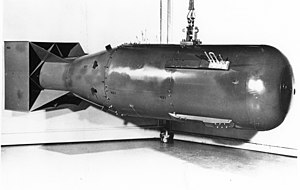Manhattan Project
 From RationalWiki - Reading time: 3 min
From RationalWiki - Reading time: 3 min
| Splitting more than hairs Nuclear energy |
| Ionizing pages |
“”Now we are all sons of bitches.
|
| —Kenneth Bainbridge, director of the Trinity nuclear test[1] |
The Manhattan Project was the codename for the development of the nuclear bomb during World War II by European and American scientists in the United States.
It is an example of a crucial moment in history when science and rationalists stepped up to the plate and delivered the long ball. At the same time, it also made possible one of the most terrifying scenarios ever devised. Sigh.
Brief description[edit]
The Manhattan Project grew out of research into nuclear fission. Nominally controlled by the Army Corps of Engineers under General Leslie Groves, the scientific work was directed by Robert Oppenheimer, a brilliant physicist who brought together some of the greatest scientific minds in the world to solve the "problem" of nuclear weapons (i.e. how to build them). Starting with theoretical research, the project moved to a purpose-built site in Los Alamos, New Mexico. Following a successful test in New Mexico in 1945, and President Truman's approval, two bombs were dropped on the Japanese cities of Hiroshima and Nagasaki. The amount of influence the bombings had on the surrender of Japan is disputed — but is most commonly accepted to have been a strong factor.
Personnel[edit]
Any list of scientists involved in the Manhattan Project is likely to be incomplete, but among those involved were:
- Leo Szilard
- Hans Bethe
- Enrico Fermi
- Richard Feynman
- John von Neumann
- Robert Oppenheimer
- Frederick Seitz
- Louis Slotin
 , who died of radiation poisoning
, who died of radiation poisoning - Edward Teller, who later became the "Father of the Hydrogen Bomb" and of the Star Wars
moviemissile defense project - Stanislaw Ulam, who invented the very important Monte Carlo method
 for statistical analysis on this project, because apparently it's a rule that every breakthrough in statistics must involve something horrific, like Eugenics or Guinness beer.
for statistical analysis on this project, because apparently it's a rule that every breakthrough in statistics must involve something horrific, like Eugenics or Guinness beer.
The project was also riddled with evil libural communist spies (though in order to avoid detection, some of them had to be competent physicists and actually contribute to the project, for example Klaus Fuchs)
Effects[edit]
The discoveries made during the Manhattan Project not only resulted in a functional nuclear weapon, but also kick-started the entire field of nuclear engineering. The first nuclear submarine was completed only 17 years after the phenomenon of nuclear fission was first discovered, with the first nuclear power plant following one and a half years later. The success of the Manhattan Project was a significant factor in the fundamental shift in the way science was done. Before World War II, basic research was conducted by lone scientists or small groups working at academic institutions or large companies. After Manhattan, national governments became the primary patrons of science, and the most important discoveries were increasingly made as a result of large-scale projects which brought together thousands of people and utilized enormous machines. This modern paradigm is called Big Science (not to be confused with the similarly named conspiracy theory).
References[edit]
- ↑ Memorial Minute - Kenneth Tompkins Bainbridge, The Harvard Gazette
 KSF
KSF

